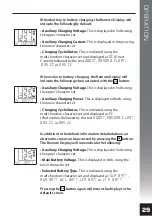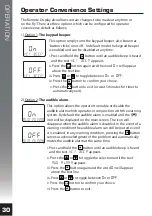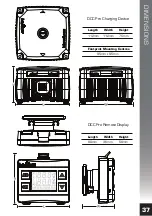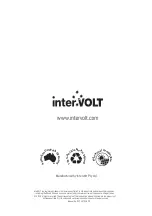
APPENDIX
38
Fundamentals in Detail
CHARGING FUNCTIONS
Soft start:
This function is the initial phase of the boost/CC stage cycle. In soft
start the current is allowed to build gradually, effectively controlling the high
inrush current normally experienced at ‘switch on’. Controlling the inrush current
reduces the risk of further damage if the battery is unserviceable and prevents
potential issues with any equipment that may be powered from the battery at the
time. Many manufacturers refer to a soft starting feature as an additional stage. In
reality however it is simply another process used for controlling the boost/CC cycle
to properly manage the auxiliary battery.
Thermal control:
This function is enabled when the temperature of the Charging
Device rises above a pre-set limit. When the environmental temperature exceeds
50°C and the Charging Device is under full load (25 Amps), thermal control is
initiated. When thermal control is activated it enters a pre-programmed control
mode allowing current output to continue subject to temperature rise. As the
temperature increases the current is reduced proportionally over time so that the
charging process can still be maximised for the hottest of conditions.
Input Voltage control:
This function is incorporated to compensate for Voltage
drop caused by undersize cable, poor connections, improper termination, etc. by
comparing the input Voltage at the main battery terminal with the Voltage at the
Charging Device itself. It does this by momentarily disconnecting the auxiliary
battery, thereby removing the load. At this time it measures the Voltage without
load to determine the true Voltage. It will then establish if the true Voltage is high
enough to continue charging or to implement low Voltage shut down.
Override Timer Control:
This function utilises an inbuilt timer which allows the
system to re-instate the last charging stage if the main charging source is
interrupted for any reason within a 30 minute period. For example, if the system
was in boost/CC and a fuel stop was required within 15 minutes of setting out,
upon re-starting the vehicle, the system will remember and re-instate the
boost/CC stage of the charging cycle. If the system was in float/CV stage at the
time and the voltage drops over the 30 minute period, the boost/CC stage may be
initiated.
CONTROL MODES
Voltage control mode:
In Voltage control mode the charging control process is
automatic and is based on Voltage sensed at the input and output terminals of the
Charging Device. When the main battery Voltage rises above 13.0V the system will
commence operation. The charging cycle is determined by the auxiliary battery
Voltage and may enter boost/CC or float/CV stage depending on this Voltage.
Conversely, if the Voltage of the main battery drops below 12.6V the system will
revert to stand by. If solar power is actively available, PV stage may be initiated.



















